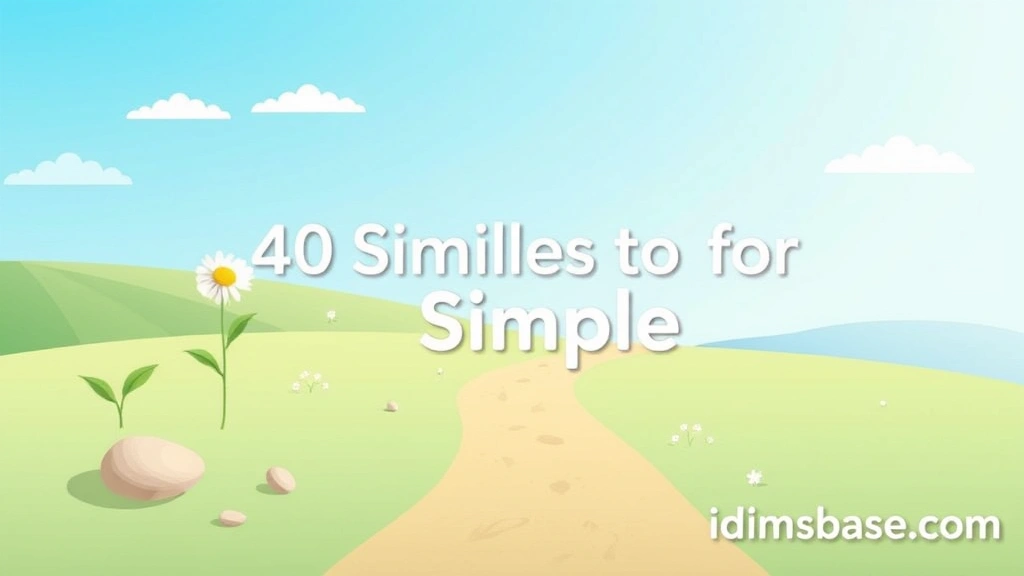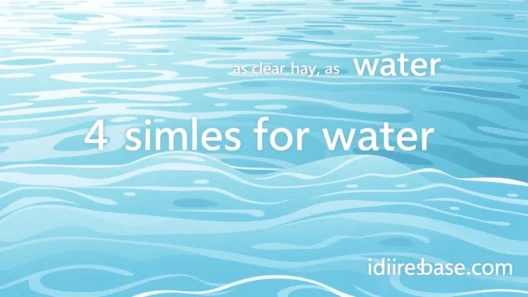Are you searching for the perfect way to describe something as… well, simple? Sometimes, that one word just doesn't quite capture the essence, does it? You want to paint a clearer picture, add a touch of flair, or perhaps make your writing sing a little more! You've landed in just the right place because we're about to dive into a treasure trove of 40 delightful similes that will help you express "simple" in countless creative ways. Get ready to expand your vocabulary and charm your readers!
Why Similes for "Simple" Are So Handy
You might be wondering, "Why do I need 40 ways to say simple?" Great question! Think about it: using the same word repeatedly can make your writing feel a bit flat, like a deflated balloon. Similes, on the other hand, breathe life into your descriptions. They create vivid images in your reader's mind, making your prose more engaging, memorable, and impactful. Plus, they show off your linguistic prowess!
Whether you're writing a novel, crafting a marketing message, or just trying to explain a complex idea in an easy-to-understand way, these similes are your secret weapon. Let's embark on this exciting linguistic journey!
40 Similes for "Simple"
Here's our fantastic list of similes, each offering a unique shade of "simple." Get ready to pick your favorites!
- As simple as ABC: This classic implies fundamental ease, something anyone can grasp.
- As simple as 1, 2, 3: Similar to ABC, it suggests a straightforward, step-by-step process.
- As simple as breathing: Something effortless and natural, requiring no thought.
- As simple as falling off a log: Implies extreme ease, something almost impossible to fail at.
- As simple as pie: A delightful way to say something is incredibly easy and pleasant.
- As simple as child's play: Suggests something so easy, even a child could do it.
- As simple as walking: Indicating a task that requires no special skill or effort.
- As simple as blinking: An action so automatic, it's done without conscious thought.
- As simple as drawing a straight line: Emphasizes clarity and lack of complication.
- As simple as riding a bike: Once learned, it becomes second nature and easy.
- As simple as snapping your fingers: Suggests instantaneous and effortless completion.
- As simple as turning a page: A very easy, uncomplicated action.
- As simple as saying "hello": A basic, common interaction.
- As simple as black and white: Denotes clear, unambiguous, and easy to understand.
- As simple as day and night: Highlights a clear distinction, leaving no room for confusion.
- As simple as basic arithmetic: Refers to fundamental calculations that are easy to perform.
- As simple as a nursery rhyme: Suggests something straightforward, easy to remember, and perhaps even comforting.
- As simple as peeling a banana: A task that requires minimal effort or skill.
- As simple as putting on socks: A routine, effortless action.
- As simple as drinking water: Something essential and easily done.
- As simple as a push of a button: Implies automated ease and minimal interaction.
- As simple as a single step: Suggests that the entire process is just one easy movement.
- As simple as a straight path: No twists, turns, or complications.
- As simple as a clear sky: No clouds, no confusion, just pure clarity.
- As simple as a gentle breeze: Light, unburdened, and easy to experience.
- As simple as a whisper: Quiet, uncomplicated, and direct.
- As simple as a smile: A natural, effortless expression.
- As simple as plain toast: Unadorned, basic, and uncomplicated.
- As simple as a single note: Pure, singular, and uncomplicated by harmony.
- As simple as a tap on the shoulder: A direct, uncomplicated way to get attention.
- As simple as a nod: A straightforward, non-verbal communication.
- As simple as opening a door: A common, easy action.
- As simple as tying a shoelace: A well-practiced, easy skill.
- As simple as a clear stream: Transparent, easy to see through, and navigate.
- As simple as a basic recipe: Follows clear steps to an easy outcome.
- As simple as a friendly wave: A common, effortless gesture.
- As simple as a single thought: Pure, uncomplicated by other ideas.
- As simple as a quiet evening: Peaceful, uncomplicated, and relaxing.
- As simple as a soft pillow: Gentle, comforting, and uncomplicated.
- As simple as a fresh start: Unburdened by the past, straightforward.
How to Weave These Similes into Your Writing
Now that you have this fantastic list, how do you make the most of it? It's all about context and creativity!
Choosing the Right Simile
Not every simile fits every situation. Think about the nuance you want to convey:
- For something that's fundamentally easy to understand: "As simple as ABC" or "As simple as black and white."
- For a task that requires no effort: "As simple as breathing" or "As simple as snapping your fingers."
- For a straightforward process: "As simple as 1, 2, 3" or "As simple as a straight path."

Consider the tone of your writing. Are you being humorous? Informative? Poetic? Your simile choice should match!
Examples in Action
Let's see a few of these similes in sentences:
- "Learning the new software was as simple as child's play for the tech-savvy team." (Emphasizes ease for a specific group)
- "Her explanation of quantum physics was so clear, it felt as simple as drinking water." (Highlights clarity and effortlessness in understanding)
- "The assembly instructions were as simple as a nursery rhyme, making the task surprisingly enjoyable." (Conveys ease and perhaps a touch of pleasantness)
- "Navigating the new city with the updated GPS was as simple as turning a page." (Shows how effortless the navigation became)
See how they add flavor and precision? You're not just saying "it was simple"; you're showing how simple it was!
Beyond the List: Crafting Your Own Similes

Feeling inspired? You don't have to stop at our list! The beauty of language is that you can always create your own similes. Here's a quick tip:
- Identify the core quality: What specific aspect of "simple" are you trying to highlight? Is it effortless, clear, basic, quick?
- Brainstorm comparisons: What else in the world shares that quality? Think about everyday actions, natural phenomena, or common objects.
- Formulate the simile: "As [adjective] as [noun]."
For instance, if you want something simple and quick: "As simple as a quick glance." If you want something simple and fundamental: "As simple as a primary color." The possibilities are endless!
Embracing Simplicity in Communication
In a world that often feels complex, the ability to communicate simply and clearly is a superpower. These similes aren't just about sounding clever; they're about making your message accessible and impactful. When you help your audience grasp an idea with ease, you build connection and understanding.
So, go forth and sprinkle these wonderful similes throughout your writing! Watch as your words become more vivid, your descriptions more engaging, and your message more resonant. Happy writing!

Frequently Asked Questions (FAQ)
Q1: What is a simile?
A simile is a figure of speech that directly compares two different things using the words "like" or "as" to highlight a shared quality. For example, "brave as a lion" compares bravery to a lion's known courage.
Q2: Why should I use similes in my writing?
Using similes enhances your writing by making it more vivid, descriptive, and engaging. They help readers visualize concepts, convey emotions more effectively, and add a layer of creativity and depth to your language, preventing your prose from becoming dull or repetitive.
Q3: Are there any rules for using similes effectively?
Yes! For effective similes, ensure the comparison is fresh and original, not cliché. The two things being compared should be genuinely different but share a clear, understandable characteristic. Also, make sure the simile fits the tone and context of your writing. Overusing similes can make your writing feel forced or clunky, so use them judiciously.
Q4: What's the difference between a simile and a metaphor?
The main difference lies in how the comparison is made. A simile directly compares two things using "like" or "as" (e.g., "The cloud was like a fluffy cotton ball"). A metaphor, on the other hand, directly states that one thing is another, implying a deeper, more direct equivalence without using "like" or "as" (e.g., "The cloud was a fluffy cotton ball"). Metaphors are often stronger and more evocative.
Q5: Can I create my own similes, or should I stick to common ones?
Absolutely! While common similes can be useful, creating your own unique similes adds originality and personality to your writing. It shows creativity and a deeper understanding of language. When crafting your own, think about unexpected comparisons that still make sense and resonate with your reader. This makes your writing stand out.
Q6: How can similes make complex ideas "simple" for the reader?
Similes can simplify complex ideas by relating them to something familiar and easily understood. By drawing a comparison to an everyday object or experience, you can make an abstract or difficult concept more concrete and relatable, helping the reader grasp it quickly. For example, explaining a complex network as "interconnected like a spider's web" makes it more accessible.
Q7: What are some common mistakes to avoid when using similes?
A common mistake is using clichés (e.g., "busy as a bee") that have lost their impact. Another is making comparisons that are unclear, illogical, or too obscure for your audience to understand. Also, avoid forcing similes where they don't naturally fit, as this can disrupt the flow of your writing. Always aim for clarity, originality, and relevance.
Key Takeaways
- Vivid Descriptions: Similes breathe life into your writing, creating clear mental images for your readers.
- Enhanced Engagement: They make your prose more interesting and memorable, keeping your audience hooked.
- Vocabulary Expansion: Using diverse similes enriches your linguistic toolkit and prevents repetition.
- Clarity and Impact: Similes can simplify complex ideas by relating them to familiar concepts, making your message more accessible.
- Creative Expression: Don't hesitate to craft your own unique similes to add personality and originality to your work.
- Strategic Use: Choose similes that fit your context and tone, and use them judiciously for maximum impact.





